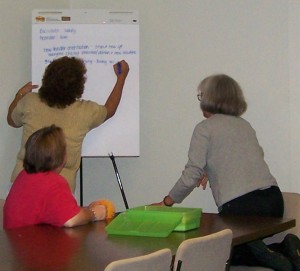Did you know that the average American spends between 3 and 5 years of their life in meetings? And most people dread every minute of that time. We are a culture that is addicted to meetings but sadly we don’t do meetings very well. Whether these meetings are related to business, community issues, or personal—success depends on good planning and a few key guidelines. Yet most of us spend very little time practicing the skills that can lead to highly productive meetings.
The are three important roles that significantly increase the effectiveness of meetings. If you want your next meeting to be a success, then begin by identifying some folks to assume the following three roles.
Timekeeper. The timekeeper’s role is to keep one eye on the agenda and one eye on the clock. As the time limit for a particular agenda item draws near it is the timekeeper’s job to speak up and make that clear to the group. This notice provides the group time to wrap up the discussion, settle on an action item or extend the discussion. In some instances when the discussion is rich and engaging, the group may decide that they would like to extend the time for that particular agenda item. This is fine provided the group agrees and that the adjustments are made to the agenda. Usually these adjustments involve postponing some item(s) to a future meeting or, more rarely, extending the meeting end time. It is important that this decision be made explicitly. Agreement should follow whatever decision-making rules (majority vote, consensus, etc.) the group has agreed to in advance.
agenda item draws near it is the timekeeper’s job to speak up and make that clear to the group. This notice provides the group time to wrap up the discussion, settle on an action item or extend the discussion. In some instances when the discussion is rich and engaging, the group may decide that they would like to extend the time for that particular agenda item. This is fine provided the group agrees and that the adjustments are made to the agenda. Usually these adjustments involve postponing some item(s) to a future meeting or, more rarely, extending the meeting end time. It is important that this decision be made explicitly. Agreement should follow whatever decision-making rules (majority vote, consensus, etc.) the group has agreed to in advance.
Recorder (aka Minute taker). There are many individuals that would agree this is the most powerful position at the table in any meeting. The keeper of the minutes is responsible for recording the decisions reached by the group and/or any action items that result from discussion. There is an art to good minute taking. Minutes, in most instances, should not be a verbatim account of the meeting. Minutes should be concise, accurate, and follow the outline agreed to by the group.
Facilitator. The final critical role in a successful meeting is the facilitator. Contrary to popular understanding the facilitator does not need to be the Chair, or convener, of the group. The  facilitator may or may not be a member of the group. The decision to recruit an external facilitator is something that should be determined well in advance of the meeting. The facilitator’s role is to protect the process of the meeting. A good facilitator will work with both the timekeeper and the recorder to ensure that the meeting is moving along, that the agenda is being followed and that there is clarity on any decisions that are made. The facilitator needs to ensure that everyone is participating, that the tone of the discussion is civil, and that everyone is staying on track. A skilled facilitator knows how to guide a group through conflict and uncomfortable discussions without alienating participants or avoiding the difficult issues.
facilitator may or may not be a member of the group. The decision to recruit an external facilitator is something that should be determined well in advance of the meeting. The facilitator’s role is to protect the process of the meeting. A good facilitator will work with both the timekeeper and the recorder to ensure that the meeting is moving along, that the agenda is being followed and that there is clarity on any decisions that are made. The facilitator needs to ensure that everyone is participating, that the tone of the discussion is civil, and that everyone is staying on track. A skilled facilitator knows how to guide a group through conflict and uncomfortable discussions without alienating participants or avoiding the difficult issues.
If you have all three of these roles filled, it is likely that your meetings will take a giant step toward success and your participants will start to appreciate meetings more.
A couple of additional considerations will make your meetings work more smoothly.
Stick to the start and end times. It is disrespectful to those that arrive on time to begin a meeting late. If there are unusual circumstances that might warrant waiting a few minutes it is good practice to check in with those present to get permission to delay the start of the meeting. Likewise, if you are in danger of going over your end time you should always acknowledge that and get agreement from those present.
Rotate the roles of facilitator, recorder, and timekeeper. This provides everyone with an opportunity to practice these skills and gives everyone some ownership of the progress of the group.





 hy is it important to welcome and train new Board members?
hy is it important to welcome and train new Board members? 







